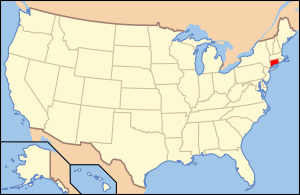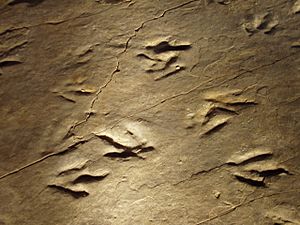Paleontology in Connecticut facts for kids

Paleontology in Connecticut is about finding and studying fossils in the U.S. state of Connecticut. It also includes research done by people from Connecticut. While Connecticut is famous for its many dinosaur tracks, other types of fossils are not as common.
The oldest fossils found in Connecticut are from the Triassic period. This was a time when the supercontinent Pangaea was starting to break apart. Large rift valleys formed and filled with water, becoming huge lakes. Many different plants, small animals without backbones (invertebrates), and reptiles lived in Triassic Connecticut. Later, in the Early Jurassic period, local dinosaurs left behind lots of footprints. These footprints later turned into fossils.
The first dinosaur bones ever found in North America and confirmed by science were discovered in Connecticut in 1818. This happened when workers were digging a well. Other important fossil finds include the armored reptile Stegomus, the crocodile-like Clepsysaurus, and the long-necked dinosaur Anchisaurus. The Jurassic dinosaur footprint Eubrontes giganteus is now the official state fossil of Connecticut.
Contents
Ancient Life in Connecticut
Connecticut has no fossils older than the Triassic period. During that time, the middle part of the state had many rivers and sandy areas. As the supercontinent Pangaea began to split apart, deep valleys called rift valleys formed. These valleys filled with water and became very large lakes.
Around 200 million years ago, a type of rock called the New Haven Arkose started to form. The crocodile-like reptile Clepsysaurus lived in Connecticut at this time. Its remains were found near Simsbury. Another plant-eating reptile, Hypsognathus, also lived in Triassic Connecticut. Its remains were found near Meriden. The armored reptile Stegomus was also present. Scientists found its skin impressions and body fossils near Fairhaven.
Connecticut's ancient small animals without backbones included at least two types of mollusks and one insect. Some trails left by these invertebrates have been preserved as trace fossils. These are more common in nearby Massachusetts. At least six types and thirteen species of ancient fish are known from Connecticut. The ancient plants of Connecticut included conifers, cycads, ferns, and rushes.
Central Connecticut continued to have rivers and sandy areas into the Jurassic period. About 95% of the dinosaur footprints at Rocky Hill belong to the type called Eubrontes. The dinosaur footprints in Connecticut and Massachusetts are sometimes seen as one large fossil site. Other reptiles and amphibians also left trace fossils in Connecticut, besides dinosaurs. At least 13 species of non-dinosaur reptile footprints are known from the state.
Connecticut has no rocks from the Cretaceous period. This means there are no fossils from that time. This gap in the rock record continues through the entire Tertiary period. However, new layers of rock formed during the Quaternary period. This happened when glaciers moved into the state. Animals preserved in these glacial deposits include relatives of modern clams, crustaceans, and snails. Their remains were found in the state's northwest and in Long Island Sound.
Discovering Connecticut's Past

In 1818, a man named Solomon Ellsworth Jr. was digging a well in East Windsor. About 18 feet underground, he found some fossil bones. These were the first dinosaur bones in North America that scientists confirmed were from a dinosaur. Two years later, Nathan Smith wrote about Ellsworth's fossils in the American Journal of Science. He thought they were human bones.
In 1823, Professor Edward Hitchcock published his research on Connecticut's fossil plants. In 1848, he wrote about the local fossil tracks. By 1858, 38 different quarries in Connecticut were known to have dinosaur tracks. However, not many new finds were made until the 1960s.
Later in the 1800s, John Bell Hatcher graduated from Yale in 1884. That same year, on October 20, an Early Jurassic long-necked dinosaur fossil was found. It was in a quarry in Manchester that belonged to Charles O. Wolcott. Workers saw the hip and back leg of the animal. But the rock block that probably held the front half of the animal had already been used to build a bridge! Othniel Charles Marsh named this dinosaur Anchisaurus major.
Four years later, Yale University received the main fossil of the crocodile-like reptile Clepsysaurus. Later, in 1892, Marsh named another species, Anchisaurus colurus. This was for another skeleton found in the Wolcott Quarry. Marsh was very impressed by how well preserved this fossil was. As of 1996, this was still the best preserved prosauropod skeleton in North America. Marsh also named Anchisaurus solus for another fossil found at the same time in the Wolcott Quarry. The Anchisaurus solus fossil was smaller and not as well preserved as Anchisaurus colurus. But it was still almost complete.
In 1896, Marsh described the fossil skin impression of the armored reptile Stegomus. This was found in the Freeman Clark Quarry in Fair Haven. A big event in the early 1900s was in 1915. The dinosaur bones found in the well in 1818 were finally identified as Anchisaurus colurus.
Places to Visit
Important People
Born in Connecticut
- Henry Fairfield Osborn was born in Fairfield on August 8, 1857. He was a famous paleontologist.
Died in Connecticut
- Charles Emerson Beecher died in New Haven on February 14, 1904. He was a paleontologist.
- Othniel Charles Marsh died in New Haven on March 18, 1899 at age 67. He was a very famous paleontologist who named many dinosaurs.
- John Ostrom died in Litchfield on July 16, 2005 at age 77. He was a paleontologist known for his work on dinosaur-bird connections.
Museums to Explore


